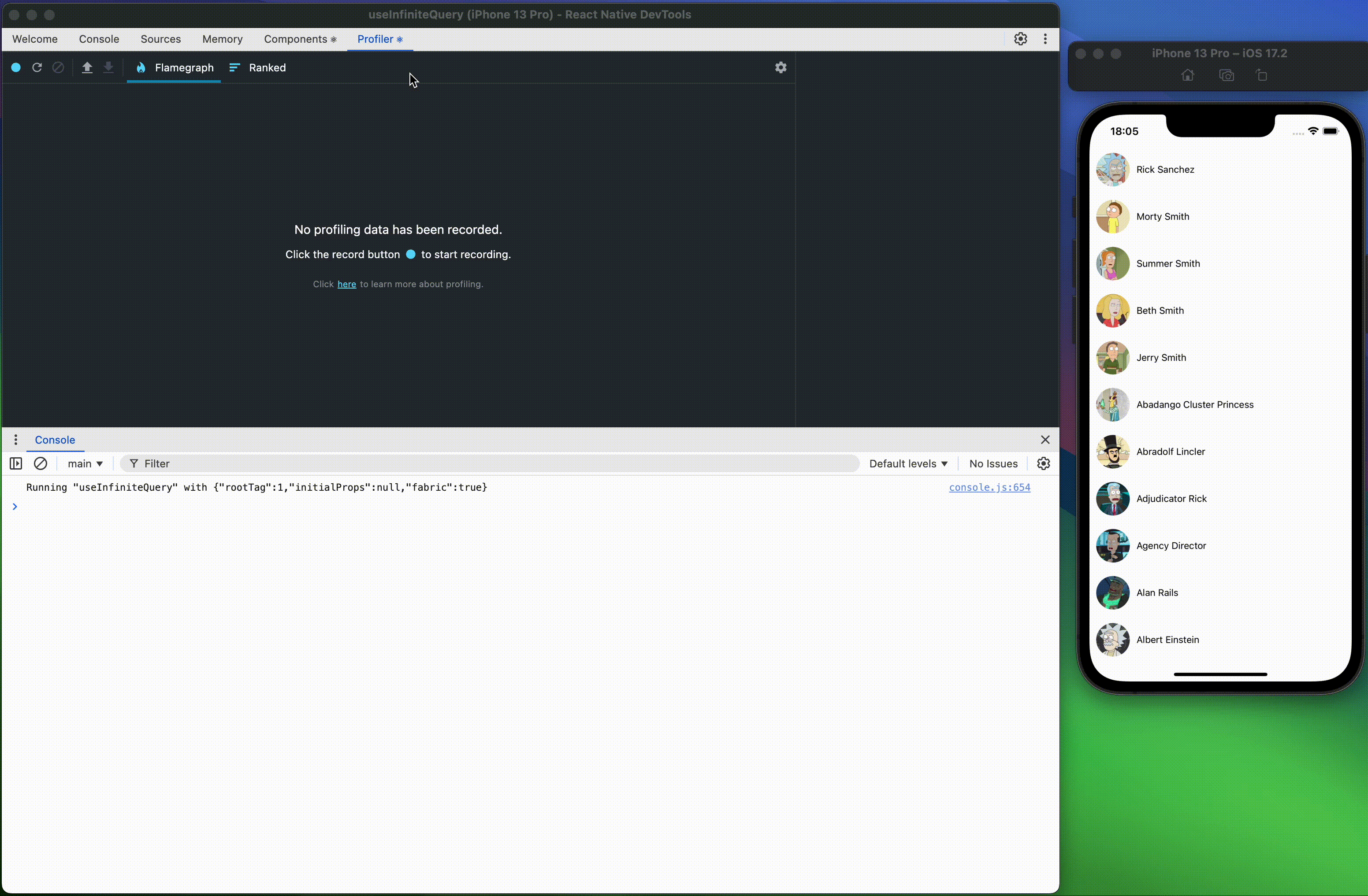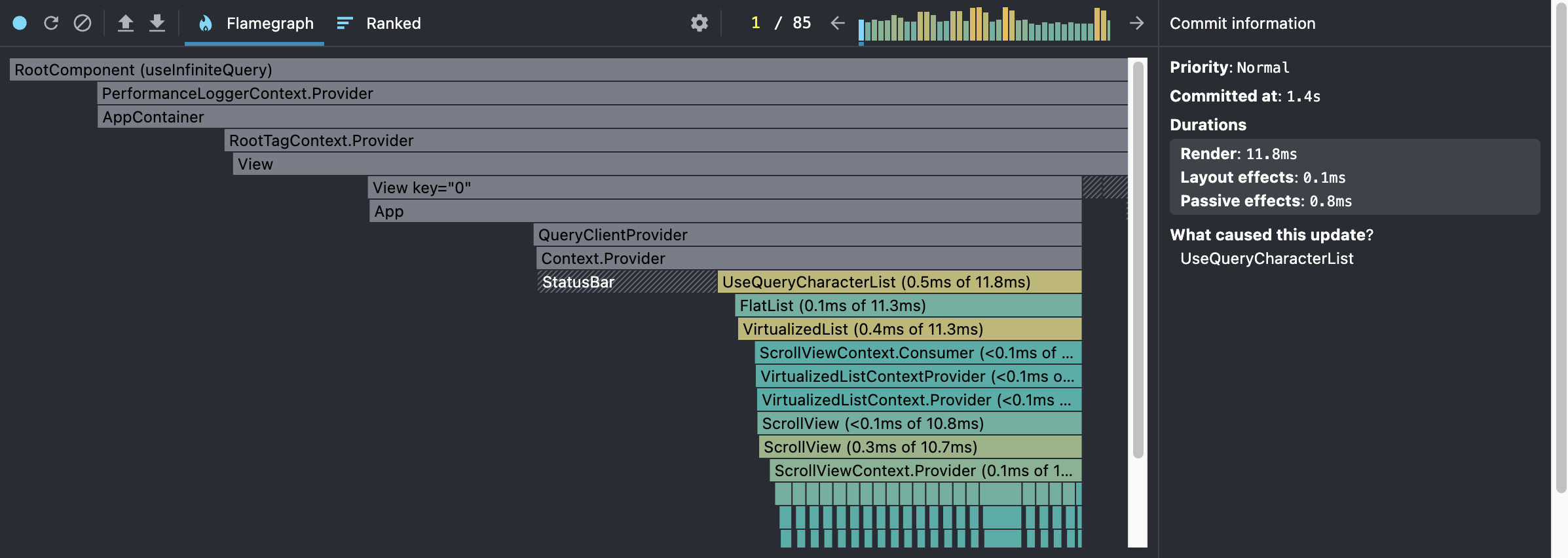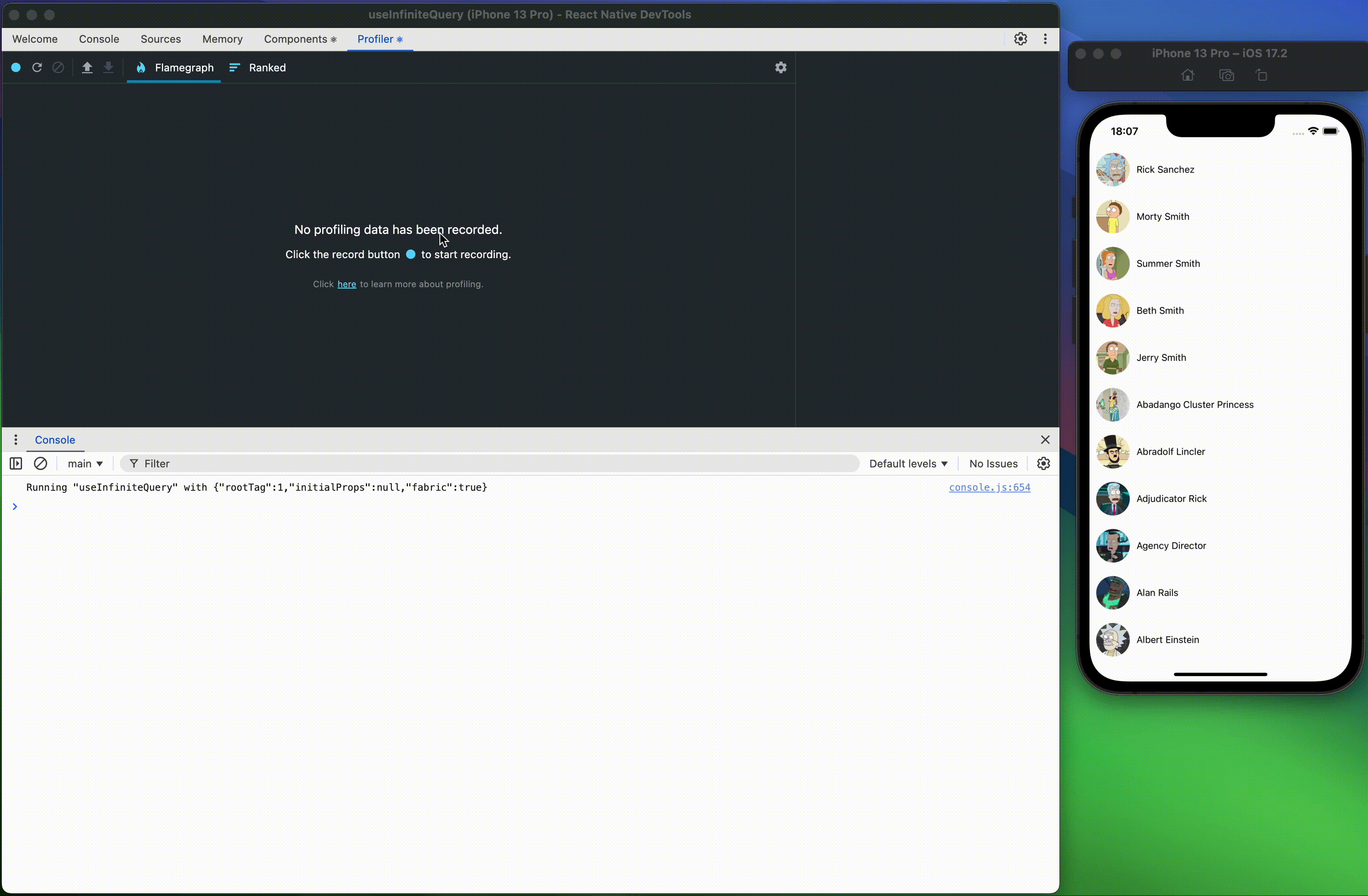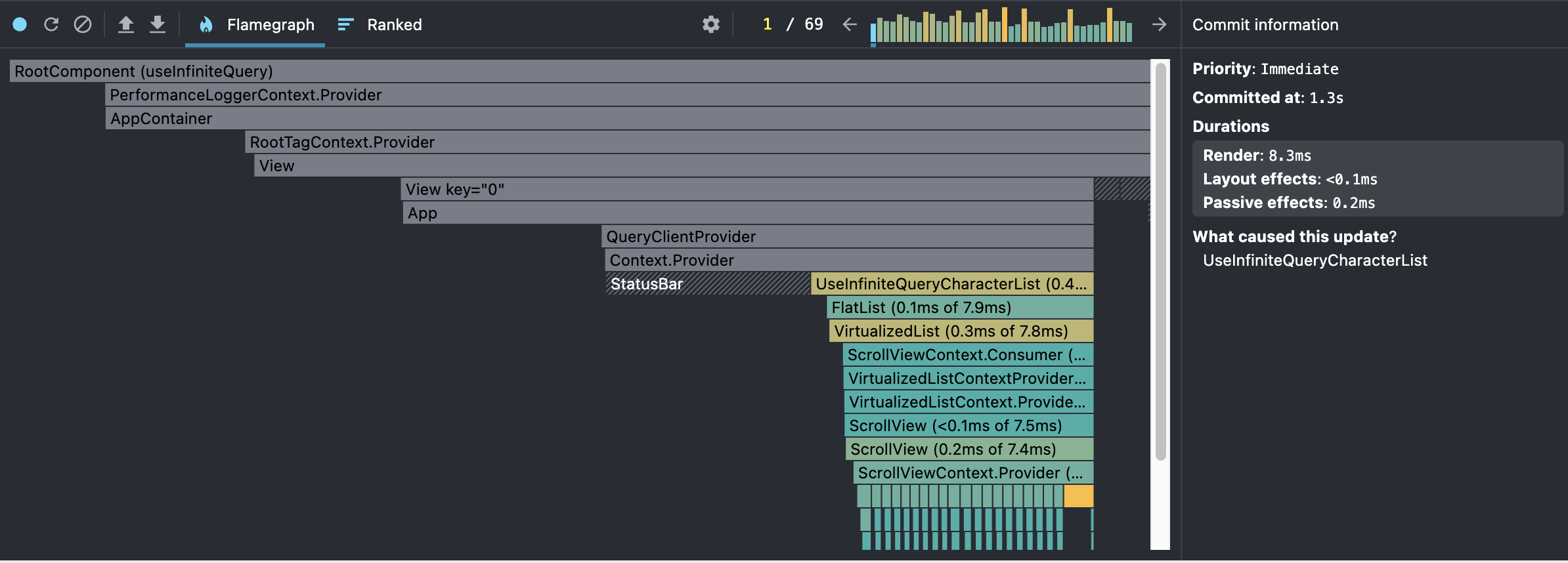
Pagination in React Native: useQuery vs useInfiniteQuery
Before we dive into pagination strategies, let’s quickly set up our environment.
To follow along, make sure you have a working React Native environment. You can start a fresh project using:
npx @react-native-community/cli@latest init AwesomeProject
Then install the necessary dependencies:
npm i @tanstack/react-query
npm i -D @tanstack/eslint-plugin-query
React Query will handle the API requests, caching, and pagination logic, while the ESLint plugin helps catch common issues and enforce best practices during development.
Now let’s explore the problem of paginated data, and how we can tackle it the right way.
The Problem: Handling Paginated Data in React Native
In many mobile apps, we often need to display large lists of items, users, posts, characters, products, etc. Since loading everything at once can hurt performance and user experience, pagination becomes necessary.
In a React Native context, it’s common to use a FlatList and load more data when the user scrolls to the bottom. But how do we manage that data properly with TanStack Query (React Query)?
Today we’ll compare two approaches:
- Using
useQuerywith manual pagination logic - Using
useInfiniteQuery, which is designed for this exact use case
In this post we’re going to use a Rick and Morty API as our data source.
Our goal is simple:
Display a list of characters showing their names and pictures using a paginated API and FlatList.
This is a great use case to explore both useQuery and useInfiniteQuery in practice.
Let’s jump in.
TL;DR
- If you’re just fetching a single set of data or manually handling pagination,
useQueryworks fine. - But if you’re implementing infinite scroll,
useInfiniteQueryis almost always the better choice: it simplifies your code, handles the edge cases for you, and leads to cleaner components.
First Solution: Using useQuery (Manual Pagination)
At first glance, it might seem like you can just change the page number and refetch the data using useQuery. And yes, it works, but you’ll have to handle a lot of things yourself:
- Tracking the current page manually
- Storing all previously fetched items
- Merging results across pages
- Checking if there’s a next page
Here’s what it looks like:
import React, { useEffect, useState } from "react";
import {
FlatList,
Text,
View,
ActivityIndicator,
StyleSheet,
Image,
} from "react-native";
import { useQuery } from "@tanstack/react-query";
type Character = {
id: number;
name: string;
image: string;
};
type APIResponse = {
info: { next: string | null };
results: Character[];
};
function delay(ms: number) {
return new Promise((resolve) => setTimeout(resolve, ms));
}
const fetchCharacters = async (page: number): Promise<APIResponse> => {
const response = await fetch(
`https://rickandmortyapi.com/api/character?page=${page}`,
);
if (!response.ok) {
throw new Error("Error when fetching characters");
}
const data = await response.json();
await delay(800);
return data;
};
export function UseQueryCharacterList() {
const [page, setPage] = useState(1);
const [allCharacters, setAllCharacters] = useState<Character[]>([]);
const [hasNextPage, setHasNextPage] = useState(true);
const { data, isLoading, isFetching } = useQuery({
queryKey: ["characters", page],
queryFn: () => fetchCharacters(page),
});
useEffect(() => {
if (data) {
setAllCharacters((prev) =>
page === 1 ? data.results : [...prev, ...data.results],
);
setHasNextPage(Boolean(data.info.next));
}
}, [data, page]);
const handleLoadMore = () => {
if (!isFetching && hasNextPage) {
setPage((prev) => prev + 1);
}
};
return (
<FlatList
data={allCharacters}
keyExtractor={(item) => item.id.toString()}
renderItem={({ item }) => (
<View style={styles.characterContainer}>
<Image source={{ uri: item.image }} style={styles.characterImage} />
<Text>{item.name}</Text>
</View>
)}
onEndReached={handleLoadMore}
onEndReachedThreshold={0.5}
ListFooterComponent={
isFetching ? <ActivityIndicator size="large" /> : null
}
ListEmptyComponent={isLoading ? <ActivityIndicator size="large" /> : null}
/>
);
}
const styles = StyleSheet.create({
characterContainer: {
padding: 10,
flexDirection: "row",
alignItems: "center",
gap: 10,
},
characterImage: {
width: 50,
height: 50,
borderRadius: 25,
},
});
This component uses the classic useQuery to fetch data from the Rick and Morty API. Every time a new page is needed, we manually keep track of the current page and update the query to fetch the next set of characters.
It renders a FlatList of characters and appends more items when reaching the end of the list, but since useQuery is not designed for infinite scroll, we need to handle things like pagination state and data merging ourselves.
I did include a small delay function, but it’s only there to slow things down a bit for the sake of this tutorial, just to make the upcoming GIFs easier to follow. Don’t worry, the useInfiniteQuery example uses it too.
⚠️ Downsides of this approach
- More boilerplate
- Harder to maintain
- Prone to bugs when merging pages
- Requires manually managing page state and list state


Let’s see how the same functionality looks with useInfiniteQuery, and also compare their performance using the React Profiler.
Second Solution: Using useInfiniteQuery (Built-in Pagination)
Now here’s how the same problem is solved using useInfiniteQuery, which was made for this:
import React from "react";
import {
FlatList,
Text,
View,
ActivityIndicator,
Image,
StyleSheet,
} from "react-native";
import { useInfiniteQuery } from "@tanstack/react-query";
type Character = {
id: number;
name: string;
image: string;
};
type APIResponse = {
info: { next: string | null };
results: Character[];
};
function delay(ms: number) {
return new Promise((resolve) => setTimeout(resolve, ms));
}
const fetchCharacters = async ({ pageParam = 1 }): Promise<APIResponse> => {
const response = await fetch(
`https://rickandmortyapi.com/api/character?page=${pageParam}`,
);
if (!response.ok) {
throw new Error("Error when fetching characters");
}
const data = await response.json();
await delay(800);
return data;
};
export function UseInfiniteQueryCharacterList() {
const { data, isFetching, fetchNextPage, hasNextPage, isFetchingNextPage } =
useInfiniteQuery({
queryKey: ["characters"],
queryFn: fetchCharacters,
initialPageParam: 1,
getNextPageParam: (lastPage) => {
const nextUrl = lastPage.info.next;
if (!nextUrl) return undefined;
const url = new URL(nextUrl);
const pageParam = url.searchParams.get("page");
return pageParam ? parseInt(pageParam, 10) : undefined;
},
});
const characters = data?.pages.flatMap((page) => page.results) ?? [];
return (
<FlatList
data={characters}
keyExtractor={(item) => item.id.toString()}
renderItem={({ item }) => (
<View style={styles.characterContainer}>
<Image source={{ uri: item.image }} style={styles.characterImage} />
<Text>{item.name}</Text>
</View>
)}
onEndReached={() => {
if (hasNextPage && !isFetchingNextPage) {
fetchNextPage();
}
}}
onEndReachedThreshold={0.5}
ListFooterComponent={
isFetching || isFetchingNextPage ? (
<ActivityIndicator size="large" />
) : null
}
/>
);
}
const styles = StyleSheet.create({
characterContainer: {
padding: 10,
flexDirection: "row",
alignItems: "center",
gap: 10,
},
characterImage: {
width: 50,
height: 50,
borderRadius: 25,
},
});
Compared to the previous version, a few things stand out immediately:
- ✅ No need for
useStateoruseEffectto manage page state. - ✅ No manual tracking of the current page or merging of data.
- ✅
useInfiniteQueryhandles all of that internally, and provides helpers likefetchNextPageandhasNextPage.
Because useInfiniteQuery returns the results in pages (each page being an API response), we just need to flatMap all results into a single array to feed into FlatList.
This structure makes the component simpler, cleaner, and easier to reason about, especially when working with paginated APIs.


Conclusion
If you’re implementing infinite scroll in React Native, prefer useInfiniteQuery over useQuery. It simplifies logic, reduces bugs, and makes your components easier to reason about.
While useQuery technically works, it quickly becomes verbose and error-prone. When the goal is to fetch more data as the user scrolls, useInfiniteQuery was built for the job.
Choose the right tool for the right scenario, and keep your scroll smooth. 🚀
Thanks for reading until the end!